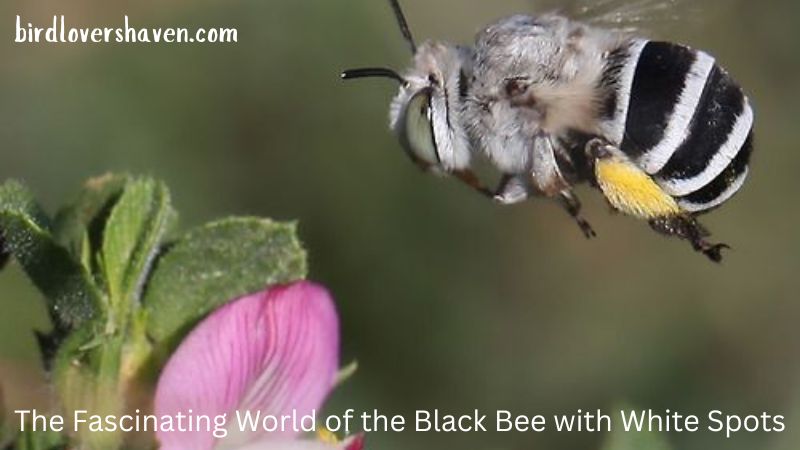Nature and Wildlife
The Fascinating World of the Black Bee with White Spots
Bees are an incredibly diverse group of insects, with over 20,000 species identified worldwide. While most people are familiar with the iconic yellow and black striped honeybee, there are many lesser-known bee species that exhibit a wide range of colors and patterns. One such intriguing variation is the black bee with white spots, an insect that captures the interest of both entomologists and nature enthusiasts alike.
In this article, birdlovershaven.com will explore the characteristics, behavior, and habitat of black bees with white spots, and delve into why these insects are important to ecosystems. We will also address common misconceptions and provide guidance on how to identify these unique bees.
Identifying the Black Bee with White Spots
Physical Characteristics
The black bee with white spots is distinguishable by its striking appearance. As the name suggests, these bees are predominantly black, with distinctive white or light-colored spots or bands on their bodies. The spots are typically found on the abdomen, but they can also appear on the thorax and legs. These markings not only make them easily identifiable but also add to their aesthetic appeal.
- Size: These bees are generally small to medium in size, similar to other solitary bees.
- Coloration: The black coloration provides a stark contrast to the white spots, making these bees quite noticeable.
- Wings: Like other bees, they have two pairs of wings which are usually transparent or slightly tinted.
Behavior and Ecology
Solitary Nature
Unlike the social honeybees, the black bee with white spots is usually solitary. This means that each female constructs and provisions her own nest without the help of workers.
- Nesting: These bees often nest in the ground, in wood, or in plant stems. Each female creates individual cells for her offspring.
- Provisions: The female bee collects pollen and nectar to create a food supply for each larva. She lays an egg on the food mass and seals the cell.
- Life Cycle: The life cycle of these bees includes egg, larva, pupa, and adult stages. The development time can vary depending on the species and environmental conditions.
Pollination
Black bees with white spots are vital pollinators. They visit a variety of flowers to collect pollen and nectar, inadvertently transferring pollen from one flower to another. This process is essential for the reproduction of many plants, including numerous crops.
- Plant Preferences: These bees are generalists, meaning they are not picky and will visit a wide range of flowering plants.
- Pollination Efficiency: Their foraging behavior makes them effective pollinators, as they can carry large amounts of pollen on their bodies.
Habitat and Distribution
Natural Habitat
The habitat of black bees with white spots can vary widely. They are adaptable and can be found in many different environments, from forests and grasslands to urban gardens and agricultural fields.
- Nest Sites: Suitable nesting sites include sandy soils, rotting wood, and hollow plant stems. Providing such habitats can encourage their presence in gardens and farms.
- Floral Resources: Access to a diverse range of flowering plants is crucial for their survival. Native plants are particularly beneficial as they provide the right nutrients and habitat conditions.
Geographical Distribution
These bees are found in various parts of the world, with different species adapted to different climates and regions.
- Range: They are commonly found in temperate regions but can also be present in tropical and subtropical areas.
- Seasonality: Their activity is typically highest during the flowering season, which varies depending on the region and climate.
Importance in the Ecosystem
Biodiversity
Black bees with white spots contribute significantly to biodiversity. Their presence indicates a healthy ecosystem with a variety of plants and nesting sites.
- Ecological Indicators: These bees can serve as indicators of environmental health and biodiversity.
- Genetic Diversity: Solitary bees like these often have higher genetic diversity than social bees, which can be beneficial for adapting to changing environments.
Agriculture
In agriculture, these bees play a crucial role as pollinators of various crops. Their contribution can enhance crop yields and quality.
- Crop Pollination: They are particularly important for the pollination of fruit trees, vegetables, and flowers.
- Economic Impact: Effective pollination by these bees can increase agricultural productivity and economic returns for farmers.
Conservation Efforts
Threats
Like many other bee species, black bees with white spots face numerous threats that impact their populations.
- Habitat Loss: Urbanization, deforestation, and agricultural expansion can lead to the loss of nesting sites and floral resources.
- Pesticides: The use of pesticides can be detrimental to these bees, affecting their health and reproductive success.
- Climate Change: Changes in climate can alter the availability of resources and suitable habitats.
Conservation Strategies
Conservation efforts are essential to protect these bees and ensure their continued role in our ecosystems.
- Habitat Creation: Providing nesting sites and planting a variety of flowering plants can support their populations. Gardens, parks, and agricultural areas can all be enhanced to be more bee-friendly.
- Pesticide Management: Reducing or eliminating the use of harmful pesticides can significantly benefit these bees.
- Research and Monitoring: Ongoing research and monitoring can help us understand their needs and develop effective conservation strategies.
Species That Feature Black Bees with White Spots

There are a few species of bees that might be referred to as black bees with white spots. Let’s explore some of these species in more detail:
1. Xylocopa virginica (Eastern Carpenter Bee)
The Eastern Carpenter Bee is one of the most well-known black bees with white markings. While these bees are predominantly black, males often have white or yellowish spots on their faces. Females, on the other hand, tend to be entirely black. These bees are large and robust, with a body length of about 1 inch.
- Habitat: Found throughout the eastern United States, often near wooded areas or in gardens.
- Behavior: Carpenter bees are solitary and are known for their habit of boring into wood to create nests, hence their name. They are important pollinators but can be mistaken for bumblebees due to their size and appearance.
2. Osmia lignaria (Blue Orchard Mason Bee)
The Blue Orchard Mason Bee is another species that can exhibit a black body with white markings. These bees are smaller than carpenter bees, with a metallic black or blue-black body and occasional light spots on their face or thorax.
- Habitat: Commonly found in North America, particularly in orchards, gardens, and wooded areas.
- Behavior: Mason bees are solitary and are known for their role in pollinating fruit trees and flowers. They use mud to construct their nests in small cavities, which is where they get the name “mason” bee.
3. Anthidium species (Wool Carder Bees)
Wool Carder Bees are another group that can display black and white patterns. These bees are typically smaller, with males having prominent white spots or bands on their black bodies. Females are usually more uniformly colored but can still exhibit faint white markings.
- Habitat: Found in a variety of habitats, including gardens, meadows, and urban areas across Europe and North America.
- Behavior: Wool Carder Bees are known for collecting plant fibers to build their nests. They are territorial and aggressive in defending their foraging areas from other bees and insects.





